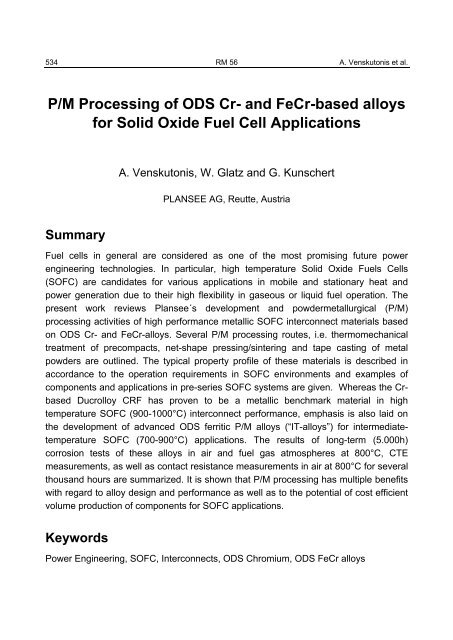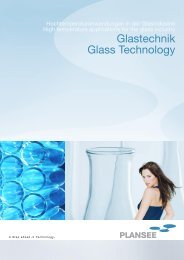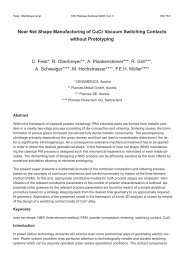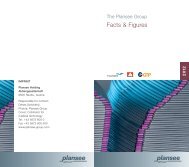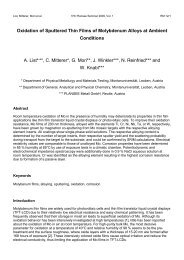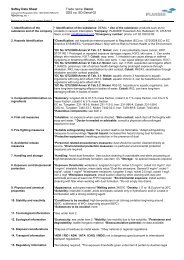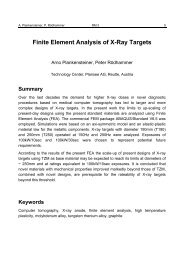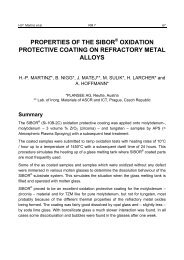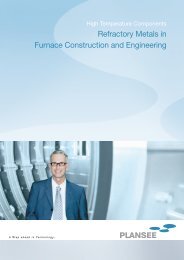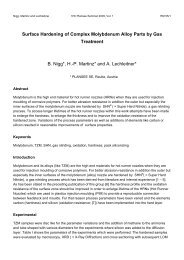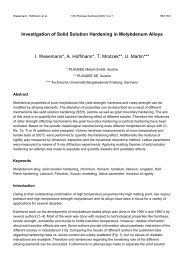P/M Processing of ODS Cr- and Fecr-based alloys for Solid Oxide ...
P/M Processing of ODS Cr- and Fecr-based alloys for Solid Oxide ...
P/M Processing of ODS Cr- and Fecr-based alloys for Solid Oxide ...
Create successful ePaper yourself
Turn your PDF publications into a flip-book with our unique Google optimized e-Paper software.
534 RM 56 A. Venskutonis et al.<br />
P/M <strong>Processing</strong> <strong>of</strong> <strong>ODS</strong> <strong>Cr</strong>- <strong>and</strong> Fe<strong>Cr</strong>-<strong>based</strong> <strong>alloys</strong><br />
<strong>for</strong> <strong>Solid</strong> <strong>Oxide</strong> Fuel Cell Applications<br />
Summary<br />
A. Venskutonis, W. Glatz <strong>and</strong> G. Kunschert<br />
PLANSEE AG, Reutte, Austria<br />
Fuel cells in general are considered as one <strong>of</strong> the most promising future power<br />
engineering technologies. In particular, high temperature <strong>Solid</strong> <strong>Oxide</strong> Fuels Cells<br />
(SOFC) are c<strong>and</strong>idates <strong>for</strong> various applications in mobile <strong>and</strong> stationary heat <strong>and</strong><br />
power generation due to their high flexibility in gaseous or liquid fuel operation. The<br />
present work reviews Plansee´s development <strong>and</strong> powdermetallurgical (P/M)<br />
processing activities <strong>of</strong> high per<strong>for</strong>mance metallic SOFC interconnect materials <strong>based</strong><br />
on <strong>ODS</strong> <strong>Cr</strong>- <strong>and</strong> Fe<strong>Cr</strong>-<strong>alloys</strong>. Several P/M processing routes, i.e. thermomechanical<br />
treatment <strong>of</strong> precompacts, net-shape pressing/sintering <strong>and</strong> tape casting <strong>of</strong> metal<br />
powders are outlined. The typical property pr<strong>of</strong>ile <strong>of</strong> these materials is described in<br />
accordance to the operation requirements in SOFC environments <strong>and</strong> examples <strong>of</strong><br />
components <strong>and</strong> applications in pre-series SOFC systems are given. Whereas the <strong>Cr</strong><strong>based</strong><br />
Ducrolloy CRF has proven to be a metallic benchmark material in high<br />
temperature SOFC (900-1000°C) interconnect per<strong>for</strong>mance, emphasis is also laid on<br />
the development <strong>of</strong> advanced <strong>ODS</strong> ferritic P/M <strong>alloys</strong> (“IT-<strong>alloys</strong>”) <strong>for</strong> intermediatetemperature<br />
SOFC (700-900°C) applications. The results <strong>of</strong> long-term (5.000h)<br />
corrosion tests <strong>of</strong> these <strong>alloys</strong> in air <strong>and</strong> fuel gas atmospheres at 800°C, CTE<br />
measurements, as well as contact resistance measurements in air at 800°C <strong>for</strong> several<br />
thous<strong>and</strong> hours are summarized. It is shown that P/M processing has multiple benefits<br />
with regard to alloy design <strong>and</strong> per<strong>for</strong>mance as well as to the potential <strong>of</strong> cost efficient<br />
volume production <strong>of</strong> components <strong>for</strong> SOFC applications.<br />
Keywords<br />
Power Engineering, SOFC, Interconnects, <strong>ODS</strong> Chromium, <strong>ODS</strong> Fe<strong>Cr</strong> <strong>alloys</strong>
A. Venskutonis et al. RM 56 535<br />
1. Introduction<br />
The requirements <strong>for</strong> suitable interconnect components <strong>of</strong> planar SOFC are<br />
challenging due to the influence <strong>of</strong> corrosive atmospheres at high temperatures<br />
ranging from 700-1000°C in combination with stresses induced during thermal cycling<br />
<strong>for</strong> e.g. APU applications or creep phenomenons caused by life cycles exceeding<br />
40.000 hours <strong>for</strong> e.g. stationary applications. Compared to advanced ceramics,<br />
metallic interconnects <strong>of</strong>fer a portfolio <strong>of</strong> attractive features such as processing<br />
reliability, robustness during service <strong>and</strong> maintenance as well as cost competitiveness.<br />
Since more than one decade, PLANSEE is actively pursueing the development <strong>and</strong><br />
production <strong>of</strong> metallic interconnect materials <strong>and</strong> components suitable <strong>for</strong> planar<br />
SOFC. In this context, PLANSEE is able to utilize sucessfully its core know-how <strong>of</strong><br />
advanced P/M processing <strong>of</strong> high per<strong>for</strong>mance materials on industrial scale [1,2,3,4,5].<br />
P/M <strong>ODS</strong> <strong>Cr</strong>-alloy, i.e. Ducrolloy CRF or similar <strong>alloys</strong> are introduced as a technology<br />
applicable <strong>for</strong> high temperature SOFC systems as well as P/M <strong>ODS</strong> ferritic Fe<strong>Cr</strong>-<strong>alloys</strong><br />
to apply as interconnect to intermediate temperature SOFC. A current overview <strong>of</strong> the<br />
industrial base at PLANSEE is given to reveal that the chosen approach <strong>of</strong> P/M<br />
processing technology combined with high per<strong>for</strong>mance materials is most adequate to<br />
gain suitable metallic SOFC interconnects at competitive costs <strong>and</strong> with the<br />
perspective <strong>of</strong> industrially available quantities.<br />
2. Background<br />
P/M technology <strong>of</strong>fers a wide range <strong>of</strong> processing to generate sound bulk material <strong>and</strong><br />
components from high per<strong>for</strong>mance materials. Alloys which can not be processed<br />
adequately by ingot metallurgy (I/M) due to their reactivity with crucible materials or<br />
which have functional compositions or complex consolidation paths which are difficult<br />
or impossible to be adjusted by I/M processes can advantageously be processed by<br />
P/M technologies. Exemplarily, Fig. 1 reveals schematically 3 basic P/M processing<br />
routes which PLANSEE is pursueing on an industrial scale <strong>for</strong> the fabrication <strong>of</strong> mill<br />
products <strong>and</strong> components <strong>for</strong> SOFC interconnects made <strong>of</strong> <strong>ODS</strong> <strong>Cr</strong>- <strong>and</strong> Fe<strong>Cr</strong>-<strong>alloys</strong>.<br />
Beside the classical process <strong>of</strong> P/M mill product <strong>and</strong> component fabrication via thermomechanical<br />
treatment <strong>and</strong> subsequent machining, PLANSEE was able to transfer its<br />
knowledge about volume production <strong>of</strong> P/M components, derived e.g. from automotive<br />
industry, to SOFC interconnects in succesfully applying a net-shape (NS) pressing <strong>and</strong>
536 RM 56 A. Venskutonis et al.<br />
sintering approach [6]. In this context presents Fig. 2 an example <strong>of</strong> NS processed <strong>Cr</strong><strong>based</strong><br />
interconnects <strong>for</strong> the SOFC pre-series systems HXS1000 Premiere <strong>of</strong> the<br />
Sulzer Hexis AG (CH) [7].<br />
Fig. 1 Industrial P/M processing technologies <strong>for</strong> the manufacture <strong>of</strong> metallic<br />
interconnects <strong>and</strong> porous substrates <strong>for</strong> SOFCs.<br />
Fig. 2 Example <strong>of</strong> <strong>Cr</strong>-<strong>based</strong> metallic interconnects processed via NS pressing <strong>and</strong><br />
sintering on industrial scale equipment <strong>for</strong> the Sulzer Hexis AG (CH) pre-series<br />
SOFC systems HXS1000Premiere.
A. Venskutonis et al. RM 56 537<br />
Furthermore, P/M processing <strong>of</strong> <strong>ODS</strong> Fe<strong>Cr</strong> pre-alloyed powders enables the<br />
preparation <strong>of</strong> metallic porous substrates which are applicable to metal supported cell<br />
concepts <strong>of</strong> intermediate temperature SOFCs (Fig. 3) [8].<br />
Fig. 3 Morphology <strong>of</strong> a metallic porous P/M substrate <strong>based</strong> on a Fe<strong>Cr</strong>-alloy (left) <strong>and</strong><br />
example <strong>of</strong> foil material processed from P/M Fe<strong>Cr</strong>-alloy (right).<br />
3. Experimental<br />
The different P/M manufacturing routes illustrated in Fig. 1 depend on carefully pretreated<br />
<strong>and</strong> pre-alloyed powders in order to achieve an adequate processing behavior<br />
within the specific manufacturing technology <strong>and</strong> adequate component properties. In<br />
regard to metallic SOFC interconnects, PLANSEE utilizes two different P/M alloy<br />
technologies which both feature an oxide dispersion strengthening (<strong>ODS</strong>) effect. On<br />
the one h<strong>and</strong>, <strong>Cr</strong>-<strong>based</strong> alloy <strong>Cr</strong>-5Fe-1Y2O3 <strong>for</strong> temperatures above 850 o C, on the<br />
other h<strong>and</strong> ferritic Fe<strong>Cr</strong>-<strong>based</strong> <strong>alloys</strong> which are modified by Mo, Ti, Mn <strong>and</strong><br />
miscellaenous alloying additions <strong>for</strong> temperature up to 850 o C. This in order to comply<br />
with all main physical <strong>and</strong> chemical requirements <strong>of</strong> a SOFC interconnect. Main<br />
emphasis on the development <strong>of</strong> Fe<strong>Cr</strong>-<strong>alloys</strong> was laid on improved corrosion<br />
properties in intermediate temperature SOFC relevant atmospheres compared to<br />
ferritic steels including the <strong>for</strong>mation <strong>of</strong> thin <strong>and</strong> well adherent corrosion scales with<br />
excellent contact resistance characteristics. As reference <strong>alloys</strong> in terms <strong>of</strong> property<br />
investigation, three commercially available ingot metallurgical (I/M) processed ferritic<br />
steels, ZMG 232 (trademark <strong>of</strong> Hitachi Metals), <strong>Cr</strong><strong>of</strong>er 22 APU (trademark <strong>of</strong> Thyssen<br />
Krupp VDM) <strong>and</strong> steel 446 were chosen <strong>for</strong> comparison.
538 RM 56 A. Venskutonis et al.<br />
Alloys Fe <strong>Cr</strong> Mn Ti Al Si Others<br />
ITM Bal. 26.0
A. Venskutonis et al. RM 56 539<br />
CTE x 10 -6 K -1<br />
14,0<br />
13,5<br />
13,0<br />
12,5<br />
12,0<br />
11,5<br />
11,0<br />
10,5<br />
10,0<br />
9,5<br />
Fe - 26<strong>Cr</strong> <strong>based</strong><br />
ITM <strong>alloys</strong><br />
200 400 600 800 1.000 1.200<br />
Fig. 4 CTE vs. temperature <strong>of</strong> P/M Fe<strong>Cr</strong>-alloy <strong>and</strong> <strong>Cr</strong>-alloy.<br />
Yield Strength [ MPa ]<br />
1.200<br />
1.000<br />
800<br />
600<br />
400<br />
200<br />
0<br />
<strong>Cr</strong> - 5Fe - 1 Y O<br />
2 3<br />
Temperature [ °C ]<br />
0 200 400 600 800 1.000<br />
Temperature [ °C ]<br />
ITM<br />
ZMG 232<br />
<strong>Cr</strong><strong>of</strong>er22 APU<br />
Fig. 5 0.2% YS vs. temperature <strong>of</strong> Plansee ITM alloy, ZMG232 <strong>and</strong> <strong>Cr</strong><strong>of</strong>er22APU.
540 RM 56 A. Venskutonis et al.<br />
Ultimate Tensile Strength [ MPa ]<br />
1.200<br />
1.000<br />
800<br />
600<br />
400<br />
200<br />
0<br />
0 200 400 600 800 1.000<br />
Temperature [ °C ]<br />
ITM<br />
ZMG 232<br />
<strong>Cr</strong><strong>of</strong>er22 APU<br />
Fig. 6 UTS vs. temperature <strong>of</strong> Plansee ITM alloy, ZMG232 <strong>and</strong> <strong>Cr</strong><strong>of</strong>er22APU.<br />
Although the creep properties have not yet been determined one can assume that the<br />
creep behaviour <strong>of</strong> the <strong>ODS</strong> P/M Fe<strong>Cr</strong>-alloy is superior to the I/M ferritic steels due to<br />
the elevated temperature strengthening effect <strong>of</strong> the oxide dispersoids. The higher<br />
strength characteristics might be <strong>of</strong> potential advantage in applications <strong>of</strong> thinner foil<br />
interconnects in terms <strong>of</strong> geometrical stability which might be impacted by stresses<br />
caused by thermal cycling or buckling due to corrosion scales <strong>for</strong>med over longer<br />
service times.<br />
The results <strong>of</strong> the oxidation tests per<strong>for</strong>med in laboratory air at 800°C <strong>for</strong> 5.000h are<br />
illustrated in Fig. 7. Fig. 8 shows the mass gain <strong>of</strong> P/M Fe<strong>Cr</strong> alloy compared to I/M<br />
ferritic steels after a test in 15% H2 / 85% H2O atmosphere at 800°C <strong>for</strong> 2.000h. The<br />
respective oxide layers <strong>for</strong>med during oxidation <strong>and</strong> corrosion testing have been<br />
characterized in [9].
A. Venskutonis et al. RM 56 541<br />
Fig. 7 Mass gain vs time derived from oxidation tests at 800°C in laboratory air <strong>for</strong><br />
5.000h. ITM 14 is shown in comparison to the reference sheet material<br />
ZMG232, RA 446 <strong>and</strong> <strong>Cr</strong><strong>of</strong>er22APU (oxidized in air only <strong>for</strong> 2.000 hours).<br />
Fig. 8 Mass gain <strong>of</strong> ITM 14 compared to various I/M ferritic steel material after testing<br />
in 15% H2 / 85% H2O atmosphere at 800°C <strong>for</strong> 2000h.
542 RM 56 A. Venskutonis et al.<br />
The results <strong>of</strong> the contact resistance behaviour measured in-situ at 800°C in laboratory<br />
air <strong>for</strong> 4.800h are illustrated in Figs. 9 <strong>and</strong> 10. P/M Fe<strong>Cr</strong>-<strong>alloys</strong> point out superior<br />
contact resistance behaviour in comparison to the reference <strong>alloys</strong> ZMG232 <strong>and</strong><br />
<strong>Cr</strong><strong>of</strong>er22APU also in terms <strong>of</strong> the trend <strong>of</strong> the slope (extrapolation) <strong>of</strong> the contact<br />
resistance towards the end <strong>of</strong> the test duration (see Fig. 10).<br />
-2<br />
Specific resistance [ mOhm cm ]<br />
ZMG 232<br />
<strong>Cr</strong><strong>of</strong>er22 APU<br />
ITM 14<br />
Time [ hours ]<br />
Fig. 9 Overview <strong>of</strong> the specific contact resistance vs time at 800°C in air <strong>for</strong> ITM 14 in<br />
comparison to the reference <strong>alloys</strong>.<br />
-2<br />
Specific resistance [ mOhm cm ]<br />
<strong>Cr</strong><strong>of</strong>er22 APU<br />
ITM 14<br />
Time [ hours ]<br />
Fig. 10 Detail <strong>of</strong> the specific contact resistance vs time at 800°C in air <strong>for</strong> ITM 14 in<br />
comparison to I/M <strong>Cr</strong><strong>of</strong>er22APU.
A. Venskutonis et al. RM 56 543<br />
5. Conclusions<br />
Advanced P/M processing techniques have been established at PLANSEE <strong>and</strong> have<br />
shown their capability <strong>for</strong> the fabrication <strong>of</strong> high per<strong>for</strong>mance metallic interconnects<br />
<strong>and</strong> porous metallic substrates <strong>for</strong> planar SOFC applications. By utilizing these<br />
technologies a variety <strong>of</strong> significant advantages are achieved in terms <strong>of</strong> reliable<br />
processing as well as the capability <strong>of</strong> net-shape fabrication <strong>of</strong> interconnects, <strong>of</strong>fering<br />
cost efficient production potential on an industrial scale.<br />
On the other h<strong>and</strong>, P/M alloy technology enables the use <strong>of</strong> advanced <strong>ODS</strong> <strong>Cr</strong>- <strong>and</strong><br />
Fe<strong>Cr</strong> <strong>alloys</strong>. Both exhibit a combination <strong>of</strong> properties which are well suited to comply<br />
with the challenging requirements <strong>for</strong> planar SOFC interconnects.<br />
In particular, the achieved results on the P/M <strong>ODS</strong> metallic interconnect materials<br />
revealed advantages in terms <strong>of</strong> low contaminations with Al <strong>and</strong> Si, homogeneity <strong>of</strong> the<br />
microstructure <strong>and</strong> the oxide dispersoid additions <strong>and</strong> improved alloy design abilities<br />
by means <strong>of</strong> homoneneous implementation <strong>of</strong> functional alloying elements. These<br />
features are highly advantageous to achieve a range <strong>of</strong> superior properties in terms <strong>of</strong><br />
CTE, corrosion resistance, contact resistance <strong>and</strong> mechanical strength which appear<br />
to be beneficial <strong>for</strong> SOFC applications at intermediate <strong>and</strong> high temperatures<br />
compared to commercially available I/M state-<strong>of</strong>-the-art ferritic steels.<br />
PLANSEE will continue to pursue ef<strong>for</strong>ts in regard to its <strong>ODS</strong> P/M materials technology<br />
<strong>for</strong> SOFC interconnetcs to achieve a more detailed underst<strong>and</strong>ing <strong>of</strong> the processingproperty-relationship,<br />
e.g <strong>Cr</strong> evaporation behavior or stability under electrochemical<br />
stack conditions. On the other h<strong>and</strong>, P/M processing technologies will be further<br />
improved to generate at PLANSEE a sound <strong>and</strong> competitive industrial base <strong>for</strong> the<br />
fabrication <strong>of</strong> interconnects made <strong>of</strong> flat mill products, porous substrates or net-shape<br />
pressed <strong>and</strong> sintered components. In summary, the recently established status<br />
revealed that it will remain an interesting challenge as well as an ambitious perspective<br />
<strong>for</strong> PLANSEE in collaboration with its partners <strong>and</strong> customers to further aim a balance<br />
<strong>of</strong> suitable materials, adequate P/M processing methods <strong>and</strong> sound stack per<strong>for</strong>mance<br />
at acceptable cost.
544 RM 56 A. Venskutonis et al.<br />
References<br />
[1] W.Köck, H.-P.Martinz, H.Greiner <strong>and</strong> M.Janousek, “Development <strong>and</strong><br />
<strong>Processing</strong> <strong>of</strong> Metallic <strong>Cr</strong> <strong>based</strong> Materials <strong>for</strong> SOFC Parts”, in <strong>Solid</strong> <strong>Oxide</strong> Fuel<br />
Cells IV, The Electrochem. Society Proceedings Series PV 95-1, (M.Dokiya,<br />
O.Yamamoto, H.Tagawa <strong>and</strong> S.C.Singhal, Editors), 1995.<br />
[2] M.Janousek, W.Köck, M.Baumgärtner <strong>and</strong> H.Greiner, “Development <strong>and</strong><br />
<strong>Processing</strong> <strong>of</strong> Chromium <strong>based</strong> Alloys <strong>for</strong> Structural Parts in <strong>Solid</strong> <strong>Oxide</strong> Fuel Cells”,<br />
in <strong>Solid</strong> <strong>Oxide</strong> Fuel Cells V, The Electrochem. Society Proceedings Series PV 97-18<br />
(U.Stimming, S.C.Singhal, H.Tagawa <strong>and</strong> W.Lehnert, Editors), 1997.<br />
[3] W.Glatz, E.Batawi, M.Janousek, W.Kraussler, R.Zach, G.Zobl, “A New Low Cost<br />
Mass Production Route <strong>for</strong> Metallic SOFC-Interconnectors”, in <strong>Solid</strong> <strong>Oxide</strong> Fuel<br />
Cells VI, The Electrochem. Society Proceedings Series PV 99-19 (S.C.Singhal,<br />
M.Dokiya, Editors), Pennington, NJ, 1999.<br />
[4] W.Glatz, M.Janousek, E.Batawi, K.Honegger, “Cost efficient industrial manufacturing<br />
routes <strong>for</strong> intermediate <strong>and</strong> high temperature SOFC interconnects”, Proceedings <strong>of</strong> 4 th<br />
European SOFC Forum (Vol.2), (A.J.McEvoy, Ed.), Lucerne/Switzerl<strong>and</strong>, July 2000.<br />
[5] K.Honegger, A.Plas, W.Glatz, “Evaluation <strong>of</strong> Ferritic Steel Interconnects <strong>for</strong><br />
SOFC Stacks”, in <strong>Solid</strong> <strong>Oxide</strong> Fuel Cells VII, The Electrochem. Society<br />
Proceedings Volume 2001-16, (H.Yokokawa, S.C.Singhal, Editors), 2001.<br />
[6] W.Glatz, M.Janousek, E.Batawi, B.Doggwiler, “PM Net-Shape <strong>Processing</strong> <strong>of</strong> <strong>Cr</strong>-<br />
Based Interconnects <strong>for</strong> <strong>Solid</strong> <strong>Oxide</strong> Fuel Cells”, Proceedings <strong>of</strong> 15 th Int. Plansee<br />
Seminar Vol.1, (Eds. G.Kneringer, P.Rödhammer, H.Wildner), Reutte/Austria, 2001.<br />
[7] H.Raak, R.Diethelm, S.Riggenbach: „The Sulzer Hexis Story: From<br />
Demonstrators to Commercial Products“, Proceedings <strong>of</strong> 5 th European SOFC<br />
Forum (Vol. 1), (J.Huijsmans, Ed.), Lucerne/Switzerl<strong>and</strong>, July 2002.<br />
[8] T. Franco, M. Lang, G. Schiller, W. Glatz <strong>and</strong> G. Kunschert, “Powder metallurgical high<br />
per<strong>for</strong>mance materials <strong>for</strong> substrate-supported IT-SOFCs”, Proceedings <strong>of</strong> 6 th European<br />
SOFC Forum (Vol.1), (M. Mogensen, Ed.), Lucerne/Switzerl<strong>and</strong>, June 2004.<br />
[9] W. Glatz, G. Kunschert <strong>and</strong> M. Janousek, “Powder.metallurgical processing <strong>and</strong><br />
properties <strong>of</strong> high-per<strong>for</strong>mance metallic SOFC interconnect materials”, Proceedings <strong>of</strong><br />
6 th European SOFC Forum (Vol.3), (M. Mogensen, Ed.), Lucerne/Switzerl<strong>and</strong>, June<br />
2004.


